Jaisalmer Tourism
Jaisalmer is where you need to journey. The city of Jaisalmer also acts as the guard to western Rajasthan (and India’s) frontier. This 'Golden City’ is located close to the Pakistan border and in close proximity to the Thar Desert. The city’s most prominent landmark is the Jaisalmer Fort, also called Sonar Qila (Golden Fort). Unlike most other forts in India, Jaisalmer Fort is not just a tourist attraction. It houses shops, hotels and ancient havelis (homes) where generations continue to live.
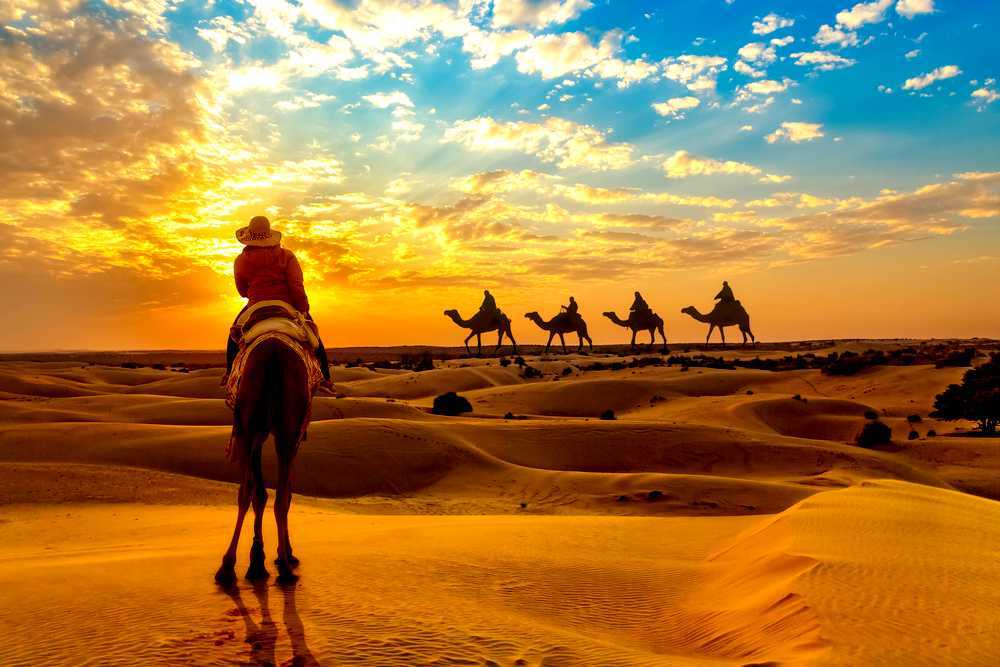
Jaisalmer traces its inception to the 12th century. History tells us of Rawal Jaisal, the eldest heir of the Rawal of Deoraj, was passed over for the throne of Lodurva and a younger half-brother was crowned king. Rawal Jaisal went looking for a new location to set up his capital when he came across sage Eesul. The sage told him about Krishna’s prophecy which said that a descendant of his Yaduvanshi clan would found a new kingdom at this same spot. It was in 1156 that Rawal Jaisal constructed a mud fort, named it Jaisalmer after himself and declared it his capital.
Famous 19 Places To Visit In Jaisalmer :-
AMAR SAGAR LAKE :-
Amar Sagar Lake, located about 7 km towards the western outskirts of Jaisalmer, is a lake cum oasis lying adjacent to the Amar Singh Palace. The palace itself was built in the 17 th century. The complex that includes the palace and the lake is also home to several ponds and wells, along with an old temple dedicated to Lord Shiva. Numerous figureheads of animals carved in stone surround the lake, and according to legends, these carved figureheads are supposed to be protectors of the royal family. At one end, there are pavilions with stairs that lead down to the lake; while at the other end is a beautiful, aesthetically carved Jain temple. A peaceful and tranquil place, the Amar Sagar Lake is yet another spot in Jaisalmer where you have an opportunity to watch a gorgeous sunset.

TANOT MATA TEMPLE :-
Some 120 kilometres away from Jaisalmer is the Tanot Mata Temple. Tanot Mata is considered to be a reincarnation of Goddess Hinglaj. There are many stories of how during the 1965 India-Pakistan war, Tanot was under heavy attack and shelling. However, none of the shells or bombs fired at the temple exploded. This reaffirmed people’s faith that Goddess the temple. Post the war, the Border Security Force (BSF) rebuilt the temple and today, the temple is managed by a BSF Trust.
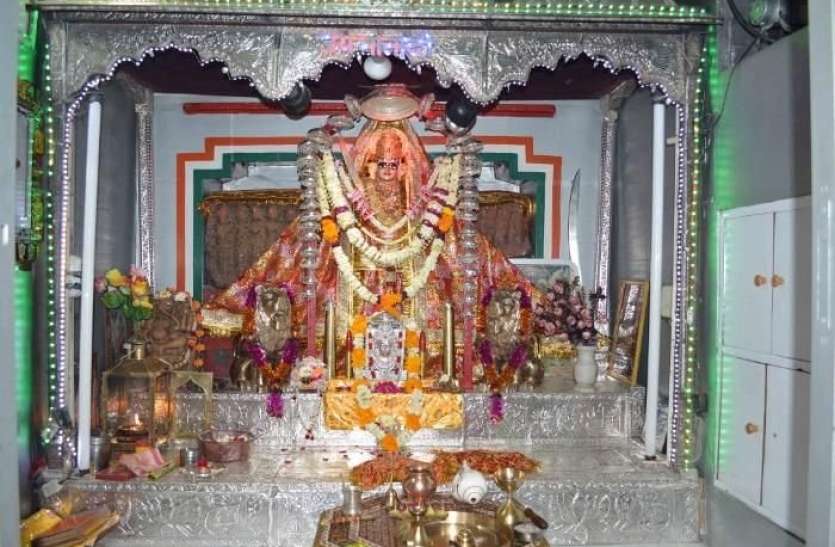
BADA BAGH :-
About 6 kilometres to the north of Jaisalmer lies Bada Bagh, also called Barabagh (literally Big Garden). This garden complex houses chhatris or royal cenotaphs of the Maharajas of Jaisalmer state, including that of Jai Singh II. The location of the garden is such that it offers wonderful sunset vistas to tourists.
JAIN TEMPLES OF JAISALMER :-
The Jain Temples located inside the Jaisalmer Fort date back to the 12th and 15th centuries. The temples are dedicated to Rikhabdevji and Shambhavdevji, famous Jain hermits known as 'Tirthankars' (wise teachers who taught people how to attain nirvana). Like all other structures in Jaisalmer, the temples are carved out of yellow sandstone. They have been built in the famed Dilwara style which is known for its beautiful architecture.

GADISAR LAKE :-
Gadisar Lake was constructed in the 14th century by Maharawal Gadsi Singh to meet the water needs of his arid lands. Considering its importance, many small temples and shrines were constructed around it, transforming it into a pilgrimage centre and a tourist attraction.
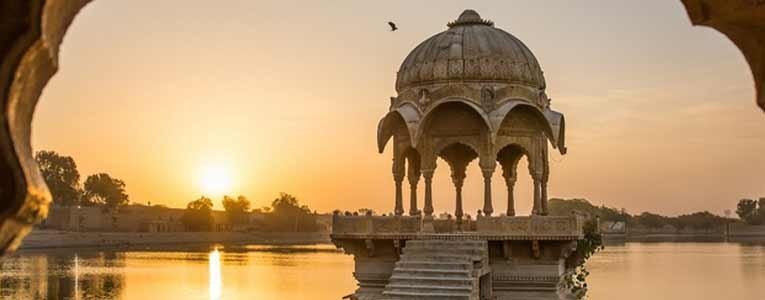
PATWON KI HAVELI :-
Among the largest and the most elaborately carved havelis in Jaisalmer, this five-storey structure sits proudly in a narrow street. While the haveli has lost some of its early glory, a few paintings and mirror work art can still be seen on the inside walls.
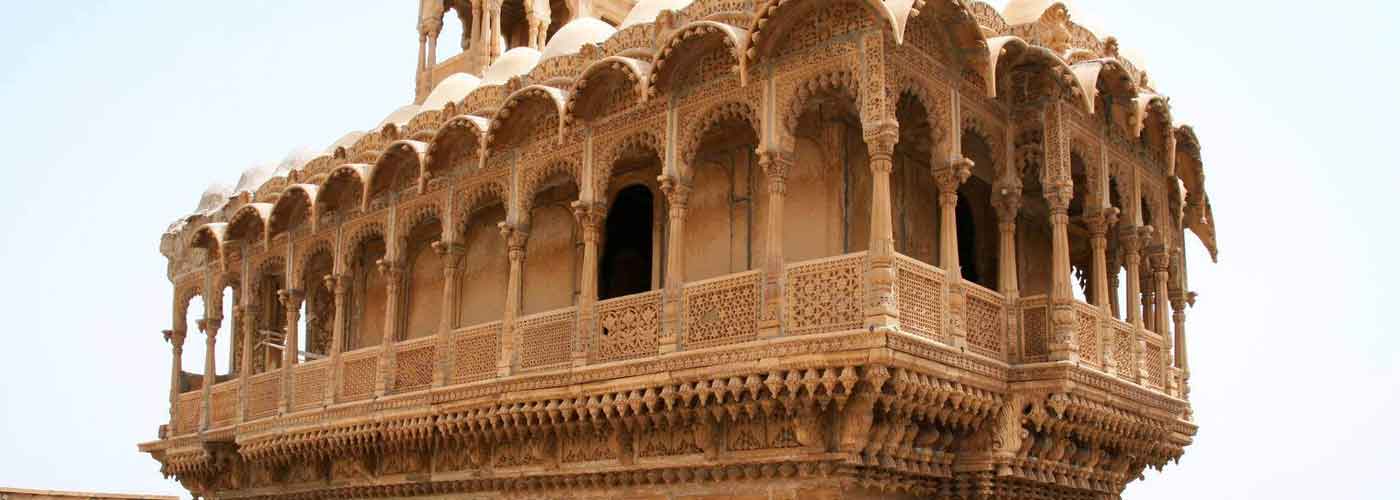
MANDIR PALACE :-
The five-storeyed majesty of the Badal Mahal (Cloud Palace) is further enhanced by its pagoda-like Tazia Tower. Each floor of the palace has an intricately carved balcony. The Badal Palace owes its beauty to the skills of Muslim craftsmen who moulded the tower in the shape of a Tazia (a float that’s part of the procession of Muharram).
NATHMAL JI KI HAVELI :-
Two architect brothers built Nathmal Ji Ki Haveli in the 19th century. They worked on the haveli from two sides and the outcome is a beautiful blend of the symmetrical construction. Miniature style paintings and mighty tuskers carved out of yellow sandstone are used for decoration.
SALIM SINGH KI HAVELI :-
This haveli was built in the first half of the 18th century and a part of it is still occupied by descendants of the original residents. The high arched roof is supported by carved brackets designed in the shape of peacocks. Legend has it that there were two additional wooden storeys that made it match the Maharaja's palace in height, but he ordered for the upper level to be demolished.

JAISALMER GOVERNMENT MUSEUM :-
Established by the Department of Archaeology and Museums, it is a prime attraction for tourists visiting Jaisalmer. The most striking display is the trophy of Rajasthan‘s state bird Godawan (the great Indian bustard). Traditional household items, rock-cut crockery, jewellery and statues from the 7th and 9th century AD displayed here are remnants of the city’s rich cultural heritage.

JAISALMER FORT :-
The Jaisalmer Fort also goes by the name Sonar Quila (Golden Fort) as it rises from the desert itself and seems to become one with the golden hues of the sand. The setting sun adds its own magic and shrouds the fort with mystique. The fort is constructed in the classic style of the royals by local craftsmen. This fort is a world heritage site and forms an important plot point in one of Satyajit Ray’s famous Feluda stories and corresponding movie, Sonar Kela (The Golden Fortress).

DESERT NATIONAL PARK :-
The Desert National Park displays the best of the Thar desert’s ecosystem and its varied wildlife. The Park is formed of undulating sand dunes, jagged rocks, dense salt lake bottoms and inter-medial areas. Various species of animals such as black buck, chinkara and desert fox inhabit the Park. The highly endangered Great Indian Bustard, one of the world's heaviest flying birds, can also be seen here. In winter, the park hosts an incredible variety of migratory raptors such Himalayan and Eurasian Griffon Vultures, Eastern Imperial Eagle, and the Saker Falcon.
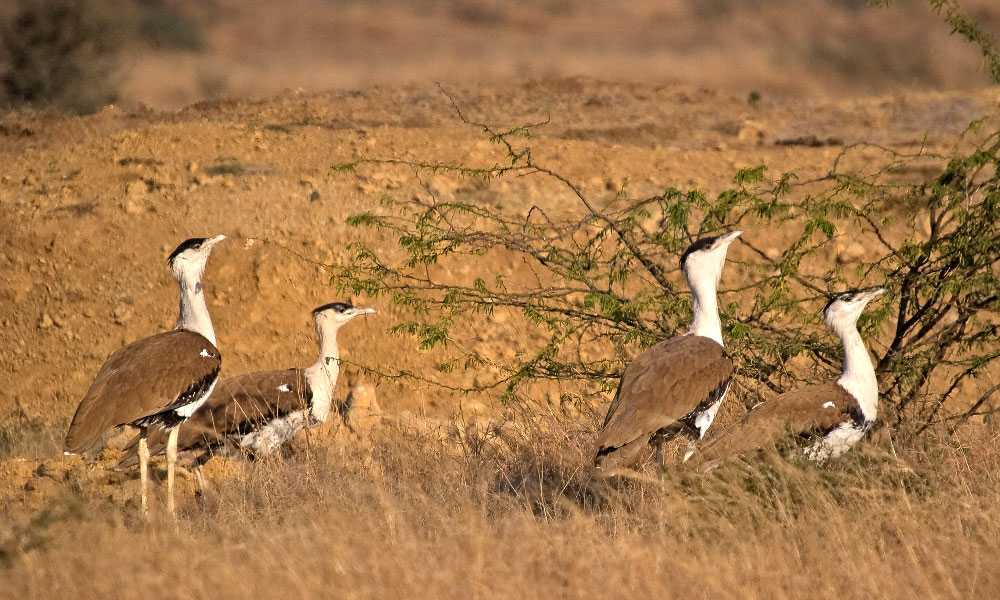
KULDHARA VILLAGE :-
The underlying history of Kuldhara has piqued the curiosity of one visitor too many, and makes it one of the most enigmatic destinations to visit in Jaisalmer, Rajasthan. The story has a beautiful daughter, an unscrupulous minister, scared villagers, an exodus in the middle of the night, and no idea where the villagers vanished. This is not the story of a movie, but the unfathomable legend that lies behind the abandoned village of Kuldhara. Located about 18 km from the city of Jaisalmer is this old town that was abandoned by its villagers in the 1800s. It was like the entire town vanished in the course of a single night. With about 85 villages full of people, it remains a mystery as to how no one saw them leave; in fact, even to this date, no one knows where all of them went either. The village remains uninhabited to the day, in the same state that the villagers had left it, hundreds of years ago. The location has become a major tourist destination as people from all over the world travel here to revel in the mysteries of the past. The desolate outline of Kuldhara etches a story in front of your eyes, if you are keen enough to read it!
JAISALMER WAR MUSEUM :-
“If you ate today, thank a farmer, and if you ate in peace, thank a soldier!” Our military and defense forces spend their days facing perils and hardships, so the citizens of India can sleep peacefully. While we all appreciate and hold respect for all they do for us, the Indian Army has commemorated the sacrifices of their soldiers in a beautiful display at this war museum, situated at the Jaisalmer military base. This exhibit is primarily to pay respect to all the soldiers who took part and lost their lives in the 1965 India-Pakistan war and the 1971 Longewala battle. A visit to this museum lets you see a number of captured tanks and other memorabilia from the battle, instilling a sense of immense pride in your country and its soldiers. The museum also features an audio-visual room where they screen movies about the battle. You can also see an interview with Major Kuldip Singh Chandpuri who was a crucial part of the Longewala battle. In the video, he gives a detailed description of how the soldiers fought the Longewala battle.
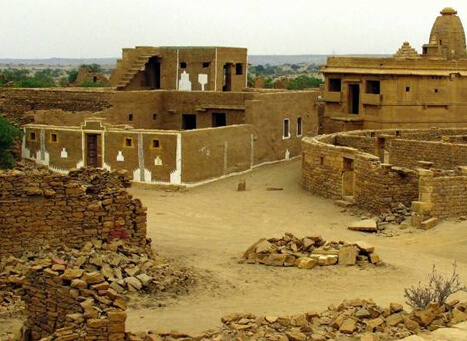
The museum also has a war memorial replete with many war trophies and vintage equipment, along with tanks, guns, and military vehicles, murals of soldiers who lost their lives in the war, and weapons which were used during the same. Even the Air Force has given a Hunter aircraft, which was used during the Battle of Longewala in the 1971 Indo-Pak War, as a present to the museum. Located on the Jaisalmer-Jodhpur Highway, the museum has free entry, and holds a very important part of our country’s history. It is truly one of the places that you cannot afford to miss.
RAMDEVRA TEMPLE :-
Located 12 kilometres from Pokhran on the Jodhpur – Jaisalmer route lies Ramdevra Temple. While most people assume it is a temple dedicated Lord Ram, it is in fact, dedicated to renowned saint Baba Ramdevji. The temple marks the eternal resting place of Baba Ramdevji and is visited by people of all faiths. Between August and September, a large fair known as Ramdevra Fair is held here, and it attracts large numbers of devotees who sing devotional songs all night long.
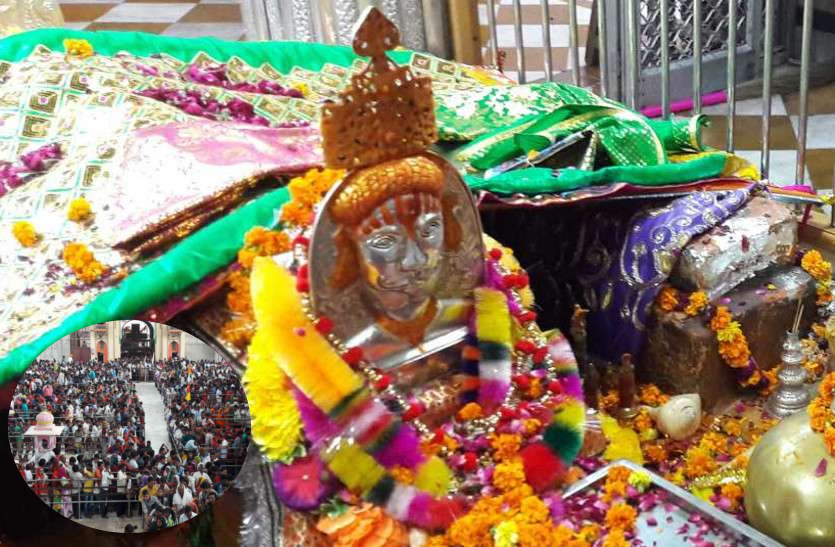
LAUNGEWALA WAR MEMORIAL :-
One of the first major engagements in the Western sector during the Indo Pakistani War of 1971, the Battle of Laungewala is an inspiring tale of courage in the face of unconquerable odds. A shining example of the courage, bravery, and valor of the Indian soldiers, the Battle of Laungewala created history on 4 December, 1971, when about a hundred Indian defenders halted the advancing troops of about 2000 Pakistani soldiers and 60 tanks. To celebrate the grit and steely resolve of the Indian soldiers who stalled Pakistani forces from their aim of cutting deep into the Indian Territory, the Desert Corps at Laungewala have constructed the Laungewala Was Memorial. An inspiring destination, this war memorial commemorates the valor and the supreme sacrifice of our brave soldiers, instilling in you a sense of pride when you visit this site

AKAL WOOD FOSSIL PARK :-
Rajasthan is a treasure trove of history and historical artifacts, but one place in particular takes you beyond the ‘timeline of present’, right into the prehistoric Jurassic era. The Akal Wood Fossil Park is a 21-hectare preserved area that lies about 17 km from Jaisalmer, towards Barmer.180 million years ago, a forest used to stand where the park is today. The area was then submersed into the sea and the tree trunks were preserved in the form of fossils. With remnants of fallen and broken logs that date back to the pre-historic times, the park is an absolute must-visit attraction. Here, you can see large fossilized trunks from trees of different sizes that have been placed in corrugated iron shelters. There are about 25 numb trees, along with centuries-old fossils, and right at the entrance, you can also stroke a fossil of an ancient red-wood tree trunk. In the geological area that had only non-flowering trees, an entire forest comprising of huge trees was fossilized. The presence of these gigantic trees suggests that in the lower Jurassic age, the area had hot and humid climate that was able to support a luxuriant forest, as compared to the stark dry climate of today.
VYAS CHHATRI :-
Vyas Chhatri is one of the most beautiful examples of Rajasthani architecture. This old Brahmin cemetery, full of local versions of cenotaphs, is dedicated to Ved Vyaas, the sage who wrote the epic, Mahabharata. Filled with cenotaphs all throughout, this place is more popularly referred to as the sunset point of Jaisalmer. Every evening, hordes of people visit the Vyas Chhatri to get a glimpse of the beautiful desert sunset. Everywhere around here you can see beautiful golden sandstone chhatris that are covered in intricate and delicate carvings. A popular destination among tourists, Vyas Chhatri offers a bird’s eye view of Jaisalmer, the fort, and even the adjoining areas. Visitors can also witness a number of locals at Vyas Chhatri, playing Rajasthani tunes on the algoza, a double fluted instrument, making it an experience that astounds the senses.

SAM SAND DUNES :-
Sam Sand dunes Desert Village in Jaisalmer Rajasthan. It is 40 Kms from Jaisalmer City (known as sand dunes of Thar Desert). Our Sam Sand Dunes Group of Resort's & Camp is one of the best camping sight of Thar Desert Jaisalmer.

The tents are exclusively designed to provide visitors experience of lifetime. Experience the soul of this enchanting land on a camel safari’s and Desert Jeep Safari in Sam Sand Dunes. We provides village safari for our guest through jeep & camel in desert and to feel local village lifestyle and atmosphere, an also seen Desert National Park to know about Desert wildlife and clean dunes made by nature.
Far from Jaisalmer city at Sam sand dunes, Where we offer you Perfect Desert Packages which includes Overnight stay in Swiss Cottage tent or Luxury Cottage, Camel safari, Refreshments, Warm welcome, Cultural evenings with Rajasthani performances around Roaring Camp fire, Delicious and hygienic Rajasthani Dinner with Rajasthani Breakfast.
Jaisalmer Tourism
Jaisalmer Tour Packages
Jaisalmer Attractions
Jaisalmer Car Rental Packages
Jaisalmer is where you need to journey. The city of Jaisalmer also acts as the guard to western Rajasthan (and India’s) frontier. This 'Golden City’ is located close to the Pakistan border and in close proximity to the Thar Desert. The city’s most prominent landmark is the Jaisalmer Fort, also called Sonar Qila (Golden Fort). Unlike most other forts in India, Jaisalmer Fort is not just a tourist attraction. It houses shops, hotels and ancient havelis (homes) where generations continue to live.

Jaisalmer traces its inception to the 12th century. History tells us of Rawal Jaisal, the eldest heir of the Rawal of Deoraj, was passed over for the throne of Lodurva and a younger half-brother was crowned king. Rawal Jaisal went looking for a new location to set up his capital when he came across sage Eesul. The sage told him about Krishna’s prophecy which said that a descendant of his Yaduvanshi clan would found a new kingdom at this same spot. It was in 1156 that Rawal Jaisal constructed a mud fort, named it Jaisalmer after himself and declared it his capital.
Famous 19 Places To Visit In Jaisalmer :-
AMAR SAGAR LAKE :-
Amar Sagar Lake, located about 7 km towards the western outskirts of Jaisalmer, is a lake cum oasis lying adjacent to the Amar Singh Palace. The palace itself was built in the 17 th century. The complex that includes the palace and the lake is also home to several ponds and wells, along with an old temple dedicated to Lord Shiva. Numerous figureheads of animals carved in stone surround the lake, and according to legends, these carved figureheads are supposed to be protectors of the royal family. At one end, there are pavilions with stairs that lead down to the lake; while at the other end is a beautiful, aesthetically carved Jain temple. A peaceful and tranquil place, the Amar Sagar Lake is yet another spot in Jaisalmer where you have an opportunity to watch a gorgeous sunset.

TANOT MATA TEMPLE :-
Some 120 kilometres away from Jaisalmer is the Tanot Mata Temple. Tanot Mata is considered to be a reincarnation of Goddess Hinglaj. There are many stories of how during the 1965 India-Pakistan war, Tanot was under heavy attack and shelling. However, none of the shells or bombs fired at the temple exploded. This reaffirmed people’s faith that Goddess the temple. Post the war, the Border Security Force (BSF) rebuilt the temple and today, the temple is managed by a BSF Trust.

BADA BAGH :-
About 6 kilometres to the north of Jaisalmer lies Bada Bagh, also called Barabagh (literally Big Garden). This garden complex houses chhatris or royal cenotaphs of the Maharajas of Jaisalmer state, including that of Jai Singh II. The location of the garden is such that it offers wonderful sunset vistas to tourists.
JAIN TEMPLES OF JAISALMER :-
The Jain Temples located inside the Jaisalmer Fort date back to the 12th and 15th centuries. The temples are dedicated to Rikhabdevji and Shambhavdevji, famous Jain hermits known as 'Tirthankars' (wise teachers who taught people how to attain nirvana). Like all other structures in Jaisalmer, the temples are carved out of yellow sandstone. They have been built in the famed Dilwara style which is known for its beautiful architecture.

GADISAR LAKE :-
Gadisar Lake was constructed in the 14th century by Maharawal Gadsi Singh to meet the water needs of his arid lands. Considering its importance, many small temples and shrines were constructed around it, transforming it into a pilgrimage centre and a tourist attraction.

PATWON KI HAVELI :-
Among the largest and the most elaborately carved havelis in Jaisalmer, this five-storey structure sits proudly in a narrow street. While the haveli has lost some of its early glory, a few paintings and mirror work art can still be seen on the inside walls.

MANDIR PALACE :-
The five-storeyed majesty of the Badal Mahal (Cloud Palace) is further enhanced by its pagoda-like Tazia Tower. Each floor of the palace has an intricately carved balcony. The Badal Palace owes its beauty to the skills of Muslim craftsmen who moulded the tower in the shape of a Tazia (a float that’s part of the procession of Muharram).
NATHMAL JI KI HAVELI :-
Two architect brothers built Nathmal Ji Ki Haveli in the 19th century. They worked on the haveli from two sides and the outcome is a beautiful blend of the symmetrical construction. Miniature style paintings and mighty tuskers carved out of yellow sandstone are used for decoration.
SALIM SINGH KI HAVELI :-
This haveli was built in the first half of the 18th century and a part of it is still occupied by descendants of the original residents. The high arched roof is supported by carved brackets designed in the shape of peacocks. Legend has it that there were two additional wooden storeys that made it match the Maharaja's palace in height, but he ordered for the upper level to be demolished.

JAISALMER GOVERNMENT MUSEUM :-
Established by the Department of Archaeology and Museums, it is a prime attraction for tourists visiting Jaisalmer. The most striking display is the trophy of Rajasthan‘s state bird Godawan (the great Indian bustard). Traditional household items, rock-cut crockery, jewellery and statues from the 7th and 9th century AD displayed here are remnants of the city’s rich cultural heritage.
JAISALMER FORT :-
The Jaisalmer Fort also goes by the name Sonar Quila (Golden Fort) as it rises from the desert itself and seems to become one with the golden hues of the sand. The setting sun adds its own magic and shrouds the fort with mystique. The fort is constructed in the classic style of the royals by local craftsmen. This fort is a world heritage site and forms an important plot point in one of Satyajit Ray’s famous Feluda stories and corresponding movie, Sonar Kela (The Golden Fortress).

DESERT NATIONAL PARK :-
The Desert National Park displays the best of the Thar desert’s ecosystem and its varied wildlife. The Park is formed of undulating sand dunes, jagged rocks, dense salt lake bottoms and inter-medial areas. Various species of animals such as black buck, chinkara and desert fox inhabit the Park. The highly endangered Great Indian Bustard, one of the world's heaviest flying birds, can also be seen here. In winter, the park hosts an incredible variety of migratory raptors such Himalayan and Eurasian Griffon Vultures, Eastern Imperial Eagle, and the Saker Falcon.

KULDHARA VILLAGE :-
The underlying history of Kuldhara has piqued the curiosity of one visitor too many, and makes it one of the most enigmatic destinations to visit in Jaisalmer, Rajasthan. The story has a beautiful daughter, an unscrupulous minister, scared villagers, an exodus in the middle of the night, and no idea where the villagers vanished. This is not the story of a movie, but the unfathomable legend that lies behind the abandoned village of Kuldhara. Located about 18 km from the city of Jaisalmer is this old town that was abandoned by its villagers in the 1800s. It was like the entire town vanished in the course of a single night. With about 85 villages full of people, it remains a mystery as to how no one saw them leave; in fact, even to this date, no one knows where all of them went either. The village remains uninhabited to the day, in the same state that the villagers had left it, hundreds of years ago. The location has become a major tourist destination as people from all over the world travel here to revel in the mysteries of the past. The desolate outline of Kuldhara etches a story in front of your eyes, if you are keen enough to read it!
JAISALMER WAR MUSEUM :-
“If you ate today, thank a farmer, and if you ate in peace, thank a soldier!” Our military and defense forces spend their days facing perils and hardships, so the citizens of India can sleep peacefully. While we all appreciate and hold respect for all they do for us, the Indian Army has commemorated the sacrifices of their soldiers in a beautiful display at this war museum, situated at the Jaisalmer military base. This exhibit is primarily to pay respect to all the soldiers who took part and lost their lives in the 1965 India-Pakistan war and the 1971 Longewala battle. A visit to this museum lets you see a number of captured tanks and other memorabilia from the battle, instilling a sense of immense pride in your country and its soldiers. The museum also features an audio-visual room where they screen movies about the battle. You can also see an interview with Major Kuldip Singh Chandpuri who was a crucial part of the Longewala battle. In the video, he gives a detailed description of how the soldiers fought the Longewala battle.

The museum also has a war memorial replete with many war trophies and vintage equipment, along with tanks, guns, and military vehicles, murals of soldiers who lost their lives in the war, and weapons which were used during the same. Even the Air Force has given a Hunter aircraft, which was used during the Battle of Longewala in the 1971 Indo-Pak War, as a present to the museum. Located on the Jaisalmer-Jodhpur Highway, the museum has free entry, and holds a very important part of our country’s history. It is truly one of the places that you cannot afford to miss.
RAMDEVRA TEMPLE :-
Located 12 kilometres from Pokhran on the Jodhpur – Jaisalmer route lies Ramdevra Temple. While most people assume it is a temple dedicated Lord Ram, it is in fact, dedicated to renowned saint Baba Ramdevji. The temple marks the eternal resting place of Baba Ramdevji and is visited by people of all faiths. Between August and September, a large fair known as Ramdevra Fair is held here, and it attracts large numbers of devotees who sing devotional songs all night long.

LAUNGEWALA WAR MEMORIAL :-
One of the first major engagements in the Western sector during the Indo Pakistani War of 1971, the Battle of Laungewala is an inspiring tale of courage in the face of unconquerable odds. A shining example of the courage, bravery, and valor of the Indian soldiers, the Battle of Laungewala created history on 4 December, 1971, when about a hundred Indian defenders halted the advancing troops of about 2000 Pakistani soldiers and 60 tanks. To celebrate the grit and steely resolve of the Indian soldiers who stalled Pakistani forces from their aim of cutting deep into the Indian Territory, the Desert Corps at Laungewala have constructed the Laungewala Was Memorial. An inspiring destination, this war memorial commemorates the valor and the supreme sacrifice of our brave soldiers, instilling in you a sense of pride when you visit this site

AKAL WOOD FOSSIL PARK :-
Rajasthan is a treasure trove of history and historical artifacts, but one place in particular takes you beyond the ‘timeline of present’, right into the prehistoric Jurassic era. The Akal Wood Fossil Park is a 21-hectare preserved area that lies about 17 km from Jaisalmer, towards Barmer.180 million years ago, a forest used to stand where the park is today. The area was then submersed into the sea and the tree trunks were preserved in the form of fossils. With remnants of fallen and broken logs that date back to the pre-historic times, the park is an absolute must-visit attraction. Here, you can see large fossilized trunks from trees of different sizes that have been placed in corrugated iron shelters. There are about 25 numb trees, along with centuries-old fossils, and right at the entrance, you can also stroke a fossil of an ancient red-wood tree trunk. In the geological area that had only non-flowering trees, an entire forest comprising of huge trees was fossilized. The presence of these gigantic trees suggests that in the lower Jurassic age, the area had hot and humid climate that was able to support a luxuriant forest, as compared to the stark dry climate of today.
VYAS CHHATRI :-
Vyas Chhatri is one of the most beautiful examples of Rajasthani architecture. This old Brahmin cemetery, full of local versions of cenotaphs, is dedicated to Ved Vyaas, the sage who wrote the epic, Mahabharata. Filled with cenotaphs all throughout, this place is more popularly referred to as the sunset point of Jaisalmer. Every evening, hordes of people visit the Vyas Chhatri to get a glimpse of the beautiful desert sunset. Everywhere around here you can see beautiful golden sandstone chhatris that are covered in intricate and delicate carvings. A popular destination among tourists, Vyas Chhatri offers a bird’s eye view of Jaisalmer, the fort, and even the adjoining areas. Visitors can also witness a number of locals at Vyas Chhatri, playing Rajasthani tunes on the algoza, a double fluted instrument, making it an experience that astounds the senses.

SAM SAND DUNES :-
Sam Sand dunes Desert Village in Jaisalmer Rajasthan. It is 40 Kms from Jaisalmer City (known as sand dunes of Thar Desert). Our Sam Sand Dunes Group of Resort's & Camp is one of the best camping sight of Thar Desert Jaisalmer.
The tents are exclusively designed to provide visitors experience of lifetime. Experience the soul of this enchanting land on a camel safari’s and Desert Jeep Safari in Sam Sand Dunes. We provides village safari for our guest through jeep & camel in desert and to feel local village lifestyle and atmosphere, an also seen Desert National Park to know about Desert wildlife and clean dunes made by nature.
Far from Jaisalmer city at Sam sand dunes, Where we offer you Perfect Desert Packages which includes Overnight stay in Swiss Cottage tent or Luxury Cottage, Camel safari, Refreshments, Warm welcome, Cultural evenings with Rajasthani performances around Roaring Camp fire, Delicious and hygienic Rajasthani Dinner with Rajasthani Breakfast.
Jaisalmer Tourism
Jaisalmer Tour Packages
Jaisalmer Attractions
Jaisalmer Car Rental Packages
Comments
Post a Comment